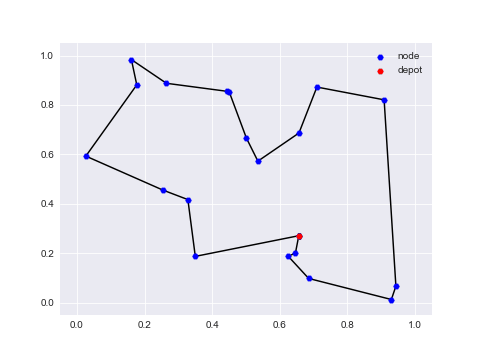DACT is a learning based improvement model for solving routing problems (e.g., TSP and CVRP), which explores dual-aspect representation, dual-aspect collaborative attention (DAC-Att) and cyclic positional encoding (CPE). It is trained by n-step Proximal Policy Optimization (PPO) with a curriculum learning (CL) strategy.
In branch new_version, we have fixed some inaccuracies in the CVRP feasibility mask calculation. As a result, we could reduce the training time of CVRP while achieving similar or even better performance. The new pre-trained models are provided in the pretrained folder, and the new results are updated in the latest ArXiv preprint.
This repo implements our paper: Yining Ma, Jingwen Li, Zhiguang Cao, Wen Song, Le Zhang, Zhenghua Chen, Jing Tang, “Learning to iteratively solve routing problems with dual-aspect collaborative transformer,” in Advances in Neural Information Processing Systems, vol. 34, 2021. Please cite our paper if the code is useful for your project.
@inproceedings{ma2021learning,
author = {Ma, Yining and Li, Jingwen and Cao, Zhiguang and Song, Wen and Zhang, Le and Chen, Zhenghua and Tang, Jing},
booktitle = {Advances in Neural Information Processing Systems},
pages = {11096--11107},
title = {Learning to Iteratively Solve Routing Problems with Dual-Aspect Collaborative Transformer},
volume = {34},
year = {2021}
}
You may be interested in our new approach called NeuOpt (NeurIPS 2023) which learns to perform more efficient and flexible k-opt exchanges and explores both feasible and infeasible regions for effective constraint handling. You may also interested in our N2S (IJCAI 2022) which makes DACT more efficient for solving pickup and delivery problems (PDPs).
We provide a Jupyter notebook to help you get started and understand our code. Please open the Jupyter notebook for more details.
Please note that in our implementation, the VRP solution is stored in a linked list format. Let us consider a TSP-20 solution [ 6 -> 17 -> 3 -> 9 -> 16 -> 4 -> 12 -> 0 -> 1 -> 5 -> 13 -> 19 -> 11 -> 18 -> 8 -> 14 -> 15 -> 7 -> 2 -> 10 -> 6], we would store this solution as rec = torch.tensor([[ 1, 5, 10, 9, 12, 13, 17, 2, 14, 16, 6, 18, 0, 19, 15, 7, 4, 3,8, 11]]),. Here, if rec[i] = j, it means the node i is connected to node j, i.e., edge i-j is in the solution. For example, edge 0-1, edge 1-5, edge 2-10 are in the solution, so we have rec[0]=1, rec[1]=5 and rec[2]=10.
- Python>=3.6 (we test on Python 3.8.2)
- PyTorch>=1.1 (we test on PyTorch 1.7.0)
- numpy
- tensorboard_logger
- tqdm
Training data is generated on the fly. Please follow repo wouterkool/attention-learn-to-route to generate validating or test data if needed. We also provide some randomly generated data in the datasets folder.
For training TSP instances with 50 nodes and GPU cards {0,1}:
CUDA_VISIBLE_DEVICES=0,1 python run.py --problem tsp --graph_size 50 --step_method 2_opt --n_step 4 --T_train 200 --Xi_CL 2 --best_cl --max_grad_norm 0.2 --val_m 1 --val_dataset './datasets/tsp_50_10000.pkl' --run_name 'example_training_TSP50'For training CVRP instances with 20 nodes and GPU card 0:
CUDA_VISIBLE_DEVICES=0 python run.py --problem vrp --graph_size 20 --dummy_rate 0.5 --step_method 2_opt --n_step 5 --T_train 250 --Xi_CL 1 --best_cl --max_grad_norm 0.04 --val_m 1 --val_dataset './datasets/cvrp_20_10000.pkl' --run_name 'example_training_CVRP20'Note: hyper-parameters ''--n_step 5 --T_train 250'' are good enough for CVRP now. And we consider loading the pre-trained models of TSP50, CVRP20, and CVRP50 to train TSP100, CVRP-50, and CVRP100 for faster convergency respectively. Please pay attention to the argument "--dummy_rate" for CVRP where we should use different values for different CVRP sizes (e.g., we use 0.5 for CVRP20, 0.4 for CVRP50, and 0.2 for CVRP100).
You can initialize a run using a pretrained model by adding the --load_path option:
--load_path '{add model to load here}'You can resume a training by adding the --resume option:
--resume '{add last saved checkpoint(model) to resume here}'The Tensorboard logs will be saved to folder "logs" and the trained model (checkpoint) will be saved to folder "outputs". Pretrained models are provided in the pretrained folders.
Load the model and specify the iteration T for inference (using --val_m for data augments):
--eval_only
--load_path '{add model to load here}'
--T_max 10000
--val_size 10000
--val_dataset '{add dataset here}'
--val_m 8
--init_val_met greedyFor inference 10,000 TSP instances with 100 nodes and no data augment:
CUDA_VISIBLE_DEVICES=0,1,2,3 python run.py --problem tsp --graph_size 100 --step_method 2_opt --eval_only --init_val_met greedy --load_path 'pretrained/tsp100-epoch-195.pt' --T_max 10000 --val_size 10000 --val_dataset './datasets/tsp_100_10000.pkl' --val_m 1 --no_saving --no_tbFor inference 512 CVRP instances with 100 nodes and 8 data augments:
CUDA_VISIBLE_DEVICES=0,1,2,3 python run.py --problem vrp --graph_size 100 --dummy_rate 0.2 --step_method 2_opt --eval_only --init_val_met greedy --load_path 'pretrained/cvrp100-epoch-190.pt' --T_max 10000 --val_size 512 --val_dataset './datasets/cvrp_100_10000.pkl' --val_m 8 --no_saving --no_tbSee options.py for detailed help on the meaning of each argument. For generalization of DACT on larger sizes and different distributions, we consider reducing the opts.P to a smaller value (see line 81 of options.py). Meanwhile, when the distribution/size is significantly different, we can consider the way 2 of generalizing CPEs (see lines 544-550 of nets/graph_layers.py) for (not guaranteed) better performance (optional). Please pay attention to the argument "--dummy_rate" for CVRP where we should use different values for different CVRP sizes (e.g., we use 0.5 for CVRP20, 0.4 for CVRP50, and 0.2 for CVRP100 by default).
The code and the framework are based on the repos wouterkool/attention-learn-to-route and yining043/TSP-improve. And we thank @small-Qing and @yzhang-gh for raising insightful issues to help improve this project.

